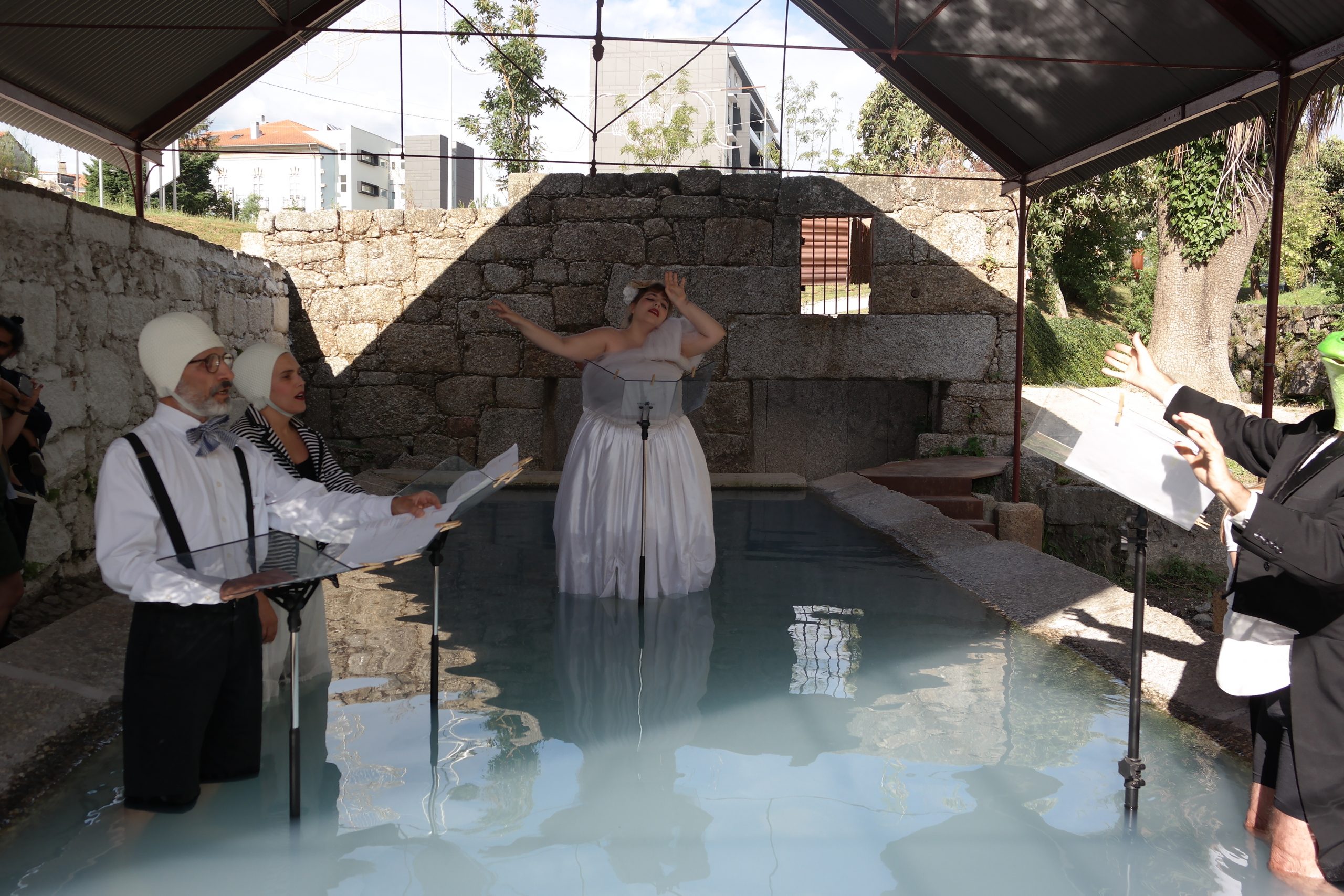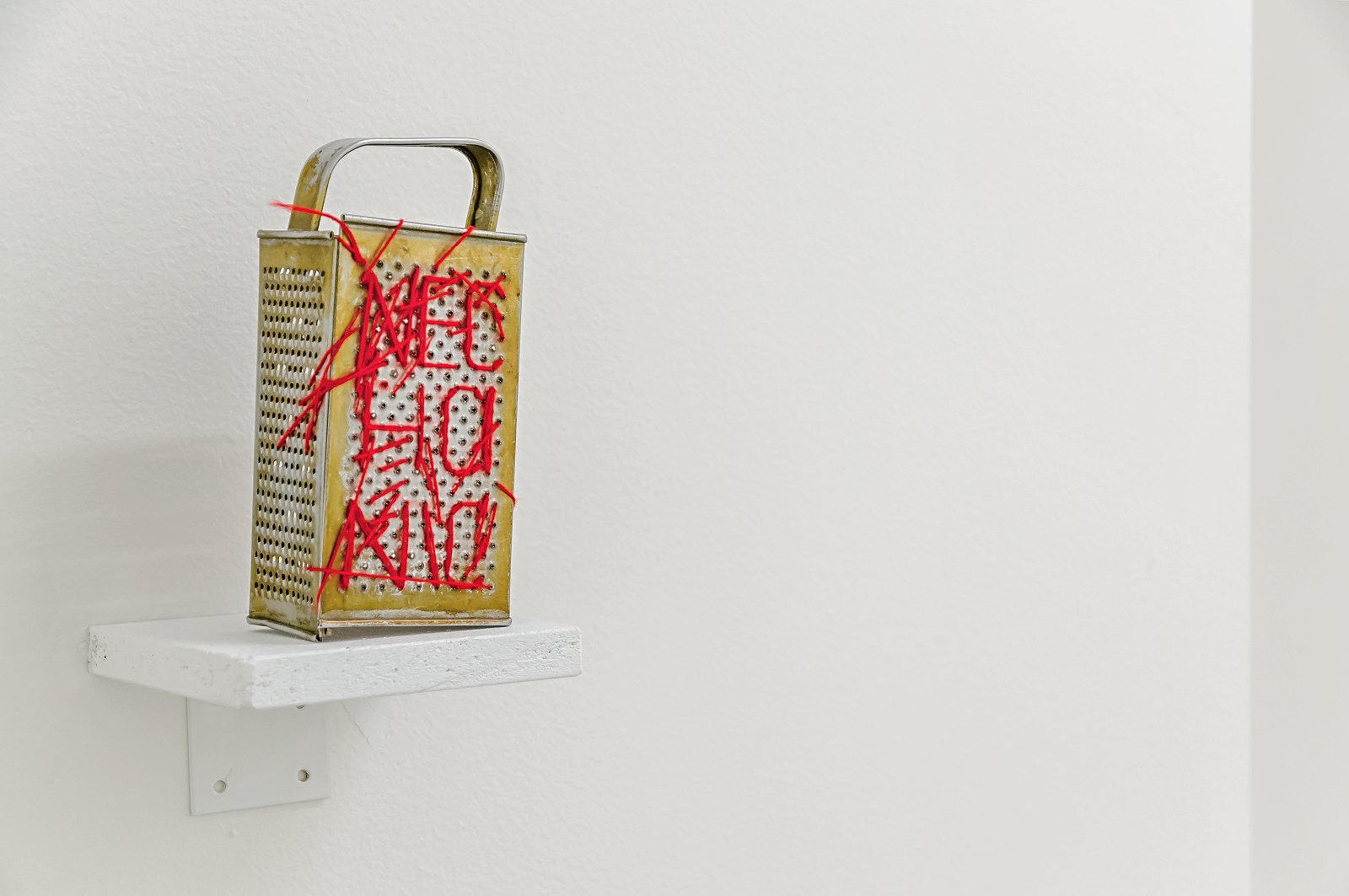All the materials from my studio – This is the seductively simple and charmingly nonchalant way in which Helena Hladilová (1983), who lives and works in Italy, describes one of her pivotal sculptures. Bearing the title My Studio, 2011, it is her quasi ironic treatment of her own primary obsession: materials and their “materiality”, their heterogeneous qualities and the virtues arising from their physical and sensory basis and last but not least their capacity to speak to the public and practical potential for presentation. A dark 20 × 30 cm cube, a kind of magical if not shamanistic dice, contains all that a talented and ambitious artist could imagine or fetishise: plaster, cement, paraffin, glass, plastic, paper, emery paper, cardboard, melting glue, clay earth, clay, wood, water, cellophane, tape, iron, acrylic paints, green paint in a spray, marble, vaseline, flour, tin, a five-cent piece, transparent gum, silver, dispersive glue – all of it stuffed into a single box, as if the materials were being forced to cohabit and have a dialogue. Here enumeration, as the vocabulary of basic materialism, ends but imagination and praxis remain open and the investigation of materials and their capacity to transform (themselves) continues. Helena Hladilová is a sculptor who – like all sculptors – searches for a new definition of sculpture through the exploration of its hybrid nature and relational character. In her projects alchemy meets recycling strategies and works become practically collective deeds with a due dose of playfulness, humour and ordinary common sense. The performance Sculpting,
2011 complements the self-reflexive attitude of My Studio by focusing on the act of creation of a statue and its transience, while approaching the human body and its likeness as active tools of sculptural production. The artist lent her friends three brand-new pairs of shoes and asked them to return them after a year of wearing them, and so changing their original shape. Hladilová exploits post-conceptual strategies of contemporary art (not only Czech) which are stressing the ephemerality and gestural character of the art work and artistic process, and concentrates on subtle shifts between reality and its representation. The artist makes interventions – of a kind not permanently registrable – in the masonry of ordinary life and the surrounding spatial (often ) context. She thus tests out the usual perception of places and objects and at the same time points out questions relating to difference and incompatibility and eventual possibilities of co-existence and belonging. In her School Project, 2011, Hladilová transformed the space of a former school which serves her as studio into a gallery exhibition space, while altering the functions and integrity of objects found there. The autonomy of places is challenged by frequent use of the act of imitating the surrounding and invisible changes of their identity. Untitled (2009) consists of a trimmed block of marble falling into a corner of the gallery, while in the work Portrait, 2010, a small colour photograph imitates the colour and structure of the wall under it, which is thus as it were covered by an identical skin providing it with protection and care.
Hladilová has mastered a highly intense poetically formal language and builds a many-sided dialogue with the active viewer, whom she challenges to attentively scrutinise and experience but also to actively participate and join in interaction. One of her performative sculptures of this kind is Harlot (2013). A kind of vagabond, promiscuous entity that makes its mark on deeper artistic exploration of the world of matter and its properties. This relatively large (210 × 100 × 85 cm) amorphous and seemingly brutal plasticine creation, set on a wheelbarrow, is reminiscent of the huge enigmatic boulder that the mythological hero Sisyphus was forced to keep rolling up the hill in his desperate and hopeless act of redemption symbolising the destructive thirst of mankind for perfection. Harlot is a stranger in the museum, captivating in its mysterious presence and monstrous manifestation of totemic and somehow archaic nature. Everything suggests that Hladilová is testing, provoking and realising her participative ritual and at the same time invoking innocent moments of early childhood, its collective creativity and the shared space of the playground. The soft and malleable plasticine is among the most basic “primary” materials that introduce us to the charms of the world of art and represent a guarantee of the accessibility of creative processes. When we model matter here with our own hands, we stand on the threshold of future form. Hladilová leaves the structure to the mercy of visitors: the statue changes, its inconstant form dependent on the interaction of visitors and their courage to join in and alter the form. These interventions are moving and expressive, impressive and unstable. Whether they add or take away, they leave an imprint on the open and friendly surface. In summary we could that they tame the seemingly unattractive matter of an abstract sculpture in an ongoing act of collective authorship. By mediating and making possible the participation of the public Hladilová shows real generosity toward the otherwise passive viewer and toward the medium of sculpture itself, while again reflecting on its “theatricality” and autonomy. Statues freed from pedestals and set immediately among people fully populate the interior of the gallery and make possible a diversity of perception and configurations. The artist is interested in the process of the emergence and transience of the medium. Swinger (2014), a collective work for which the sculptor came up with the rough shape of a gigantic head and left it to the public to finish, and Capping, 2014, a series of paint reliefs consisting in the unending layering of matter on a certain surface with the help the uncontrollable intervention of the public, are other proofs of Hladilová’s efforts to expand the capabilities of the medium (in this case performance and painting ) as spontaneous activities that establish a relationship confronting memory with the immediate act of creation. On the other hand the two works spring from the sculptor’s general ideas on public space, its creative potential and its exposure to the activity of vandals. The title Capping comes from the community of graffiti artists, and means a situation in which one writer sprays or tags over the work of another, and this then acquires a new life and becomes a monument: Hladilová freezes the moment of spontaneity and creates an archive of interventions by covering the surface moulded by the public with a layer of resin. The soft and delicate surfaces change into fixed membranes, solid matter. Although Helena Hladilová’s universe is entropic as a Smithson’s Passaic, destructive as Fontana ´s Concetto spaziale and decayed as Burri’s Combustione plastica, a place where form is born, it is also a galaxy of formlessness (informe). According to Bataille “formless [is not] a mere adjective… but a term serving to exclude the demand that every thing should have its own form… To keep academics satisfied, the universe would have to have its form. The whole of philosophy hastens toward this end. But on the other hand, it is true that to say that the universe is like nothing else and is entirely formless is the same as to declare that the universe is like a spider or a blob of spit.” Hladilová’s interest in exploring failures is something that goes beyond her interest in the fate of art and the artists (as her carpet hand woven out of destroyed paintings, which may be regarded as failures, may ironically suggest). A repertoire of surrealist techniques and iconography appears again in the sculptors most striking installation Naum, Fountain Series, 2014, also known under the title “Fake Cave”, a grotesque landscape of scattered body parts transformed into would-be picturesque fountains of long forgotten early pleasures. The organic matter scattered all around as if as a result of some apocalypse or ecological catastrophe belongs to the collapsed world of genetic errors and scientific pathology. In her desperate search for a post-human alternative Hladilová produces a likeness of the dysfunctional world system. It is an uncertain scenario of a world after a future which, as Franco “Bifo” Berardi says, has disappointed us.
Adam Budak is a curator and theorist of art and the Chief Curator of the National Gallery in Prague.
Helena Hladilová (1983 Kroměříž), currently lives and works in Italy. Together with Namsal Siedlecki she runs and curates the exhibition spaces of the GUM studio, first based in Carrara and then in Turin. Independent exhibitions (selection): 2014 Swinger, Artissima, Turin; Fake lake, CO2, Turin; 6Artista, MACRO, Rome; 2013 Vitrine. 270°, GAM, Turin; 2012 NaCI, L’A Project, Palermo (with Namsal Siedlecki); Barega, Giuseppe Frau Gallery, Gonnesa. Group exhibitions (selection): 2015 MAXXI, Rome; 2014 Fondazione Nomas, Rome; 2013 Fondazione Pastificio Cerere, Rome; Prague Biennale; 2012 Fondazione Bevilacqua la Masa, Venice; Moscow International Biennale for Young Art, Moscow; Fondazione Sandretto Re Rebaudengo, Turin; 2011 Cripta 747, Turin. Residences: Art Quarter Budapest; Fondazione Pastificio Cerere, Rome; Cité internationale des Arts, Paris; Fondazione Spinola Banna per l’Arte, Turin; Fondazione Antonio Ratti, Como.
Harlot, plasticine, wheels 210 × 100 × 85 cm, 2013 photo: artist’s archive.
Helena Hladilová My studio, plaster, cement, paraffin, glass, plastic, paper, emery paper, cardboard, hot glue, clay, wood, water, cellophane, iron, red acrylic paint, green speak paint, stucco, marble, vaseline, flour, tin, 5 cents, gum, silver, vinavil, 20 × 20 × 20 cm 2011, photo: author’s archive.
Naum, detail of the installation, ceramic, water pump, 40 × 15 × 15 cm 2014.
Capping, resin, 60 × 48 × 4 cm 2015. Photo: artist’s archive


